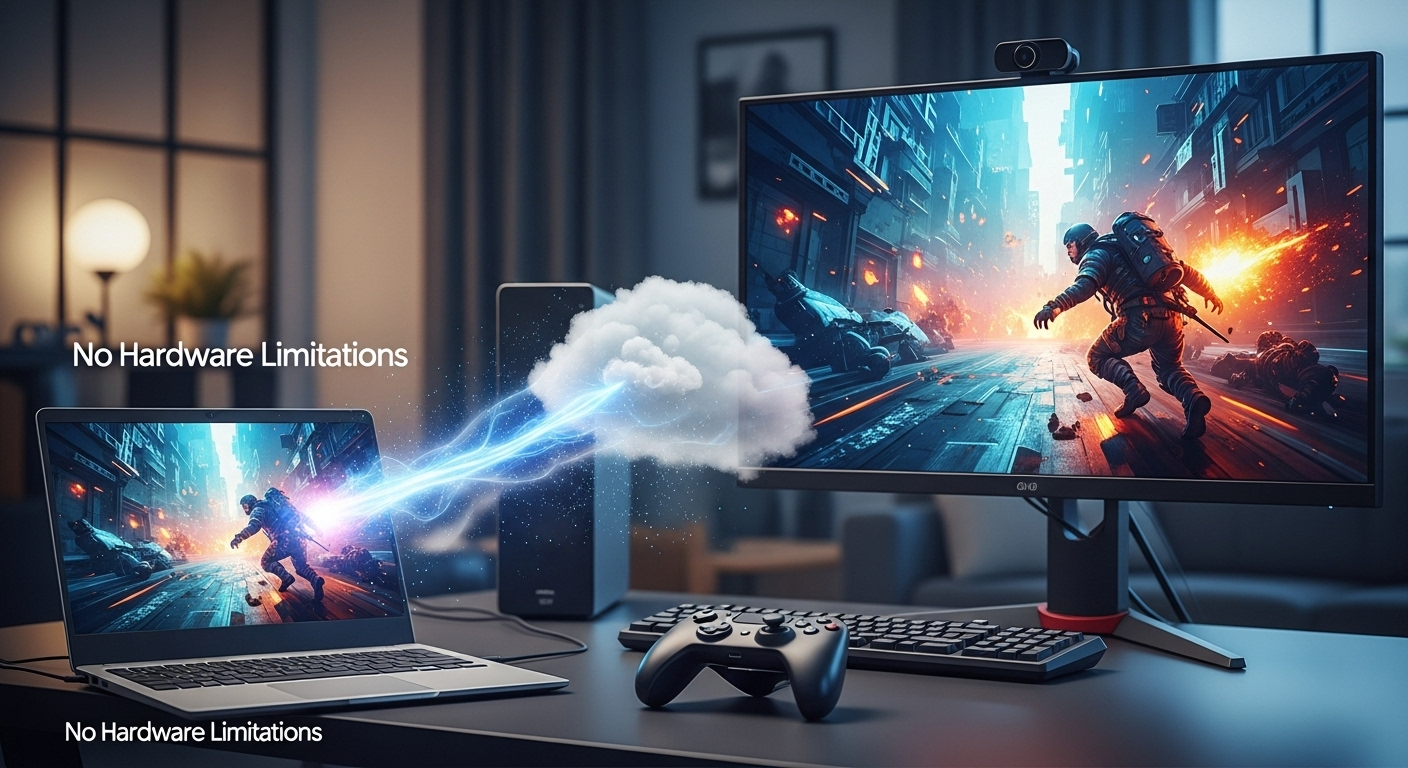The Gaming Revolution in Your Browser
Cloud gaming represents one of the most significant shifts in how we consume interactive entertainment since the transition from cartridges to discs. By streaming games directly from powerful remote servers to any internet-connected device, this technology eliminates the traditional barriers that have long defined gaming accessibility. Whether you're using a smartphone, tablet, laptop, or smart TV, cloud gaming platforms deliver console-quality experiences without requiring expensive hardware investments or lengthy downloads.
The concept isn't entirely new—services like OnLive attempted similar approaches over a decade ago—but recent advances in internet infrastructure, server technology, and compression algorithms have finally made cloud gaming viable for mainstream adoption. Major tech companies including Google, Microsoft, Amazon, and NVIDIA have invested billions in developing robust cloud gaming ecosystems, signaling their confidence in this technology's transformative potential.
Breaking Free from Hardware Limitations
Perhaps the most compelling advantage of cloud gaming is its complete liberation from hardware constraints. Traditional gaming requires consumers to purchase expensive consoles or build powerful PCs, with costs often exceeding $500 for current-generation systems and potentially thousands for high-end gaming rigs. Cloud gaming eliminates this barrier entirely by performing all processing remotely on enterprise-grade servers.
This hardware independence means you can play the latest AAA titles on devices that would normally struggle with basic web browsing. A five-year-old laptop, budget Android tablet, or even a smart TV can deliver the same visual fidelity and performance as a premium gaming setup. The only requirements are a stable internet connection and a compatible input device, dramatically expanding the potential gaming audience.
Moreover, cloud gaming future-proofs your gaming experience. As new, more demanding games release, the remote servers handling the processing can be upgraded transparently. You'll never face the frustration of discovering your hardware can't run the latest releases, nor will you need to research compatibility requirements or worry about system specifications.
Instant Access and Convenience Revolution
Cloud gaming transforms the gaming experience from ownership to access, delivering unprecedented convenience. Gone are the days of waiting hours for game downloads, managing storage space, or dealing with system updates. With cloud gaming, clicking "play" immediately launches the game, regardless of its size or complexity.
This instant accessibility proves particularly valuable for trying new games. Instead of committing to large downloads based solely on trailers or reviews, you can sample games immediately and decide whether they merit your time investment. Many cloud gaming services offer extensive libraries included with subscription fees, encouraging exploration of genres and titles you might never have considered purchasing outright.
The convenience extends beyond game access to include seamless cross-device continuity. Start playing on your phone during a commute, continue on your laptop at work during lunch, and finish the session on your TV at home—all without losing progress or dealing with save file transfers. This flexibility aligns perfectly with modern lifestyles where gaming sessions are increasingly fragmented across different locations and time periods.
Economic Advantages and Cost Efficiency
From a financial perspective, cloud gaming offers compelling value propositions that extend beyond the obvious hardware savings. While premium gaming PCs require regular upgrades to maintain performance with new releases, cloud gaming subscriptions provide access to cutting-edge hardware without the associated depreciation costs.
Consider the total cost of ownership for traditional gaming: initial hardware purchase, periodic upgrades, game purchases, and potential repair costs. A high-end gaming PC might cost $2,000-3,000 initially, require $500-1,000 in upgrades every few years, plus individual game purchases ranging from $30-70 each. Cloud gaming subscriptions typically cost $10-20 monthly while including access to extensive game libraries.
This subscription model also eliminates the risk of purchasing games you ultimately don't enjoy. Traditional gaming often involves expensive buyer's remorse when a highly anticipated title fails to meet expectations. Cloud gaming's library approach lets you explore diverse titles without individual purchase commitments, potentially exposing you to hidden gems you'd never risk buying outright.
For families, the economic benefits multiply. Instead of purchasing multiple consoles or gaming PCs for different family members, a single cloud gaming subscription can serve multiple users simultaneously on various devices throughout the home.
Enhanced Security and Maintenance Benefits
Cloud gaming provides significant security and maintenance advantages often overlooked in discussions focused on performance and accessibility. Since games run entirely on remote servers, your local devices remain isolated from potential security vulnerabilities present in game software or associated online services.
Traditional PC gaming requires constant vigilance regarding driver updates, system patches, antivirus protection, and game-specific updates. Each installed game represents a potential security vector and requires ongoing maintenance to ensure optimal performance. Cloud gaming eliminates these concerns entirely—the service provider handl
es all security measures, updates, and maintenance on enterprise-grade infrastructure with dedicated IT teams.
This managed approach extends to game saves and progress preservation. Instead of relying on local storage that could be lost due to hardware failure, cloud gaming automatically maintains your progress on redundant server infrastructure with professional backup procedures. Your gaming achievements and progress remain safe regardless of what happens to your local devices.
Additionally, cloud gaming eliminates concerns about game piracy and unauthorized modifications that can compromise system security in traditional gaming environments. The streaming model ensures games remain on secure servers while delivering only the visual and audio output to your device.
Environmental Impact and Sustainability
Cloud gaming's environmental implications present both opportunities and challenges that deserve serious consideration. On the positive side, cloud gaming can significantly reduce electronic waste by extending the useful life of existing devices and eliminating the need for frequent hardware upgrades that characterize traditional gaming.
The shared infrastructure model of cloud gaming achieves better resource utilization than individual gaming hardware. Instead of millions of gaming PCs and consoles sitting idle most of the time, cloud gaming servers can efficiently distribute computing resources across multiple users, maximizing hardware utilization and reducing overall energy consumption per gaming hour.
However, cloud gaming does shift energy consumption to data centers, which must run continuously and maintain powerful hardware. The environmental impact ultimately depends on how these data centers are powered. Companies like Google and Microsoft have committed to renewable energy for their cloud infrastructure, potentially making cloud gaming more environmentally sustainable than distributed individual gaming hardware.
The reduced need for physical game distribution also eliminates packaging, shipping, and retail infrastructure associated with traditional game sales, further reducing the environmental footprint of gaming consumption.
Performance Considerations and Current Limitations
While cloud gaming offers numerous advantages, honest assessment requires acknowledging current limitations and performance considerations. Latency remains the most significant challenge, particularly for competitive gaming scenarios requiring split-second reactions. Even with optimized networks, the round-trip time between input and visual response typically ranges from 20-100 milliseconds, compared to 1-10 milliseconds for local gaming.
Internet connection requirements present another consideration. Cloud gaming demands consistent bandwidth—typically 10-25 Mbps for 1080p gaming and 35+ Mbps for 4K experiences. More importantly, connection stability matters more than raw speed. Brief internet interruptions that barely affect web browsing can completely disrupt cloud gaming sessions.
Data consumption can be substantial, with cloud gaming using 4-20 GB per hour depending on quality settings. This consideration particularly affects users with data caps or expensive internet plans. Additionally, visual quality may not match local gaming in all scenarios, as streaming compression can introduce artifacts or reduce fine detail visibility.
Geographic proximity to servers affects performance significantly. Users in major metropolitan areas typically enjoy better experiences than those in rural locations, potentially exacerbating digital divide issues. Service availability also varies by region, with some cloud gaming platforms unavailable in certain countries due to infrastructure or regulatory constraints.
The Future Landscape of Cloud Gaming
Cloud gaming's trajectory suggests continued growth and improvement addressing current limitations. 5G networks promise reduced latency and improved mobile gaming experiences, while edge computing initiatives aim to place gaming servers closer to users, minimizing lag and improving responsiveness.
Emerging technologies like AI-powered predictive rendering could anticipate player actions and pre-render likely scenarios, effectively reducing perceived latency. Advanced compression algorithms continue improving visual quality while reducing bandwidth requirements, making cloud gaming accessible to users with modest internet connections.
The integration of cloud gaming with other cloud services presents intriguing possibilities. Imagine seamlessly transitioning from watching gaming content on YouTube to playing the featured game, or having AI assistants that can jump into games to provide help or companionship. These integrations could create entirely new gaming experiences impossible with traditional local gaming.
As internet infrastructure continues improving globally and costs decrease, cloud gaming may eventually become the dominant gaming paradigm. The convenience, accessibility, and economic advantages suggest a future where local gaming hardware becomes as antiquated as physical media, representing a fundamental shift in how we conceptualize game ownership and consumption.
The perks of cloud gaming extend far beyond simple convenience, encompassing economic, environmental, security, and accessibility benefits that collectively represent a paradigm shift in interactive entertainment. While current limitations prevent cloud gaming from completely replacing traditional gaming for all users and scenarios, the technology's rapid evolution and substantial advantages suggest an increasingly prominent role in gaming's future landscape.

